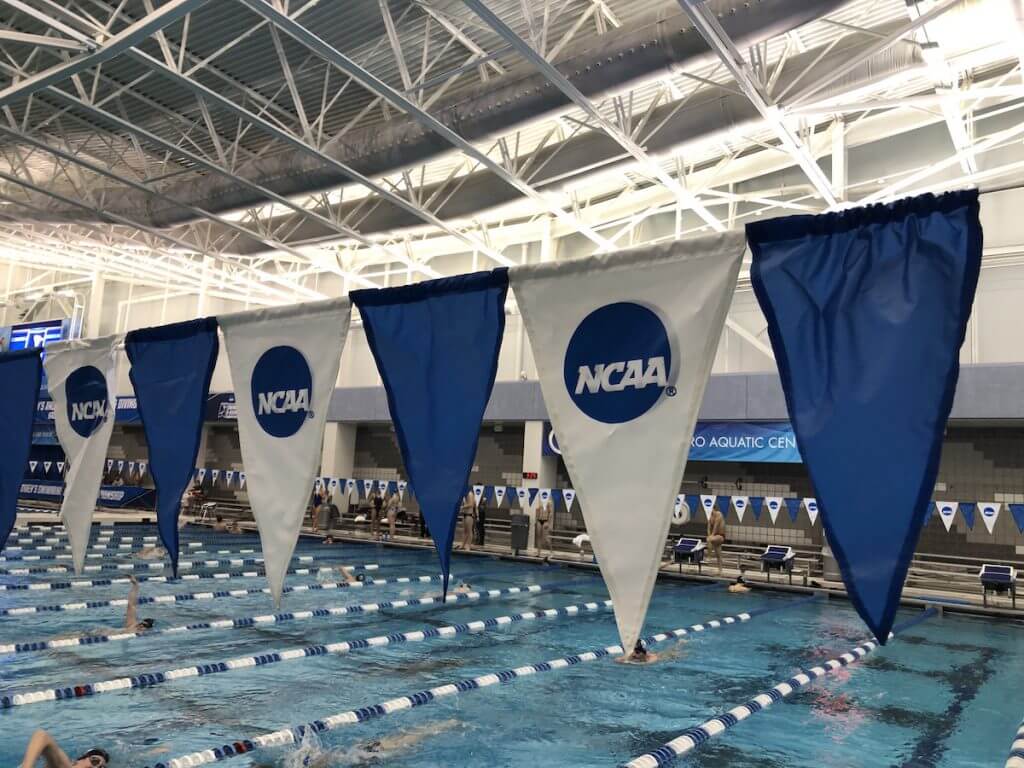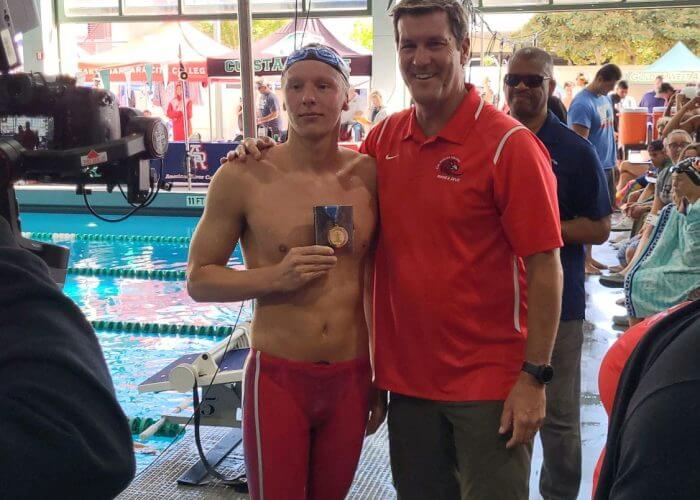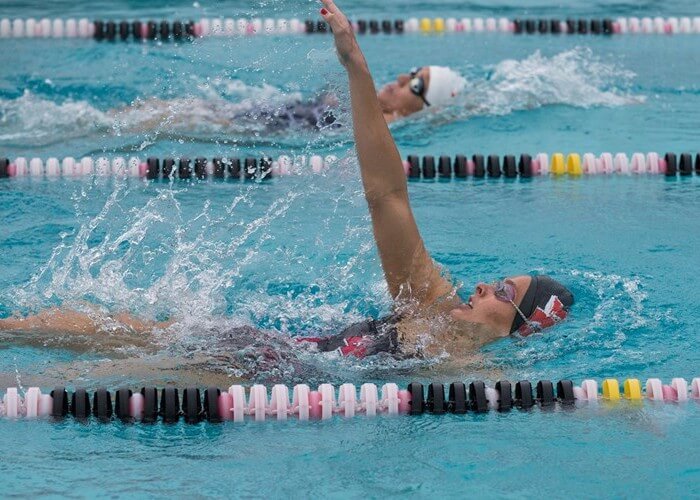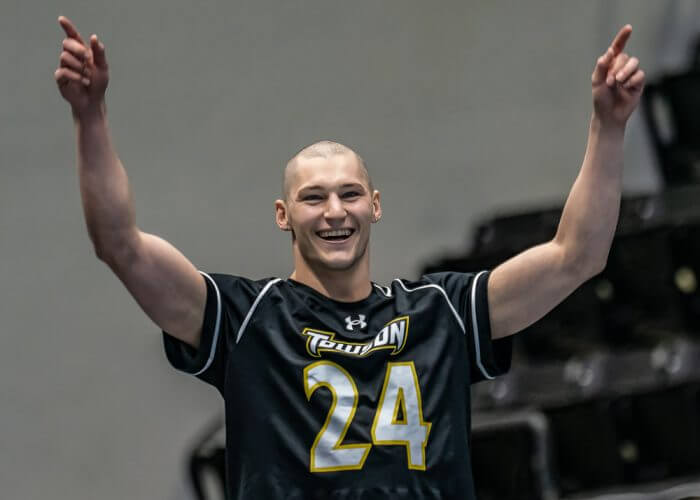The Value and Joy of Every Level of College Swimming

The Value and Joy of Every Level of College Swimming
About one in 13 high school athletes go on to compete in a varsity college sport, or a little bit above 7%. Less than two percent of those athletes compete at a Division I school. In 2023, USA Swimming had 316,263 registered athletes. As all of these athletes grow up, they’ll likely grow out of the sport, or find new hobbies. However, the swimmers who stick with it, will have their eyes set on college goals, perhaps Masters swimming down the road.
Junior/Community College

Photo Courtesy: Ahmad Zeid 2023
Hired in 2009, Jason Craighead has developed the Las Positas Hawks Aquatics program into a powerhouse over the last 15 years. The Hawks have produced four CCCAA state champions, including a distance sweep by Marcu Holunga in 2023.
An alumni of Santa Rosa Junior College, Craighead has experienced both sides of Community College swimming. He is fully aware and proud of the fact that athletes who come to him are choosing to be there,
In 2021, Esteban Perez Del Rio competed at the Puerto Rican Olympic Trials, narrowly missing the Olympic team. He experienced burnout before joining the team, but cites Craighead as the catalyst to his love of swimming returning. He’d be recruited by UNLV just 2 short years later.
During the height of the pandemic, Craighead and his staff fought for their athletes’ ability to swim. The Hawks were one of the first colleges statewide to get back in the water in July 2020.
In 2022, longtime coach Loren Pearson departed the team. Kate Faix Bennet would take on a more prominent coaching role, accompanied by new hire Kelly Gentry. Bennet is primarily a water polo coach, graduating from Sonoma State University. Gentry brings open water experience, passion, and unique methods to her coaching. The trio of Craighead, Gentry, and Bennet bring an environment to the team where the long term goals beyond swimming of every athlete matter greatly. The goal is to support an individual through their future, not just create a swimming workhorse for the short term.
NAIA
There are just over four dozen NAIA schools with swim programs in the United States. An even smaller amount offer scholarships for athletes. Despite the limited amount of programs, the diversity and opportunity given to athletes at this level provide ample options to pursue swimming in tandem with other goals.
The wide variety of NAIA programs offer unique fits for anyone seeking a spot. NAIA colleges also have considerably looser regulations compared to full NCAA programs. This setup can allow coaches the ability to have more in depth communications with athletes in the offseason. Supporters of NAIA competition cite more opportunities to compete on a national level as a motivation to seek out a college program. Many athletes will look for a “brand name” school, neglecting the potential success and happiness they could have when broadening their scope.
Another key difference offered in NAIA is the Champions of Character program. The program offers a chance for student athletes to gain awareness of learning core values on and off of the athletic stage. Integrity, respect, responsibility, sportsmanship and servant leadership make up the heart of the NAIA athletic experience.
NCAA Division II & III
Division II and Division III competitive times are generally similar, year by year. The reasons for athletes picking either level are wildly different. Division II athletes may have chosen their respective program in order to make more impact than they would have swimming Division I. Division III athletes generally are looking for a high level swim program, but still want to prioritize academics and their future careers.
East Bay Falcons
The newly named East Bay Peregrine Falcons swim team is led by Shane Pelton. A graduate of Southern Connecticut State, Pelton coached all over the country at many levels of the sport before making his way up to the East Bay area. Prior to coming to Hayward, California, he served as the assistant coach at CSU Bakersfield. His coaching experience reaches as far as Arizona State University, where he served in an assistant coaching role. His tenure was prior to the hiring of Bob Bowman and Herbie Behm. Pelton spent five years at Bridgeport University, a tenure that saw him coach multiple national champions and a national record holder.

Photo Courtesy: Cal State East Bay Athletics
In his eighth year with the Division II Falcons, Pelton took five athletes to the 2023 NCAA Division II Championships. Senior Brooklyn Dressel earned Academic All-America Third Team honors following the meet. The team has steadily built through each year, showing Pelton’s impact on his athletes. CSU East Bay sits nestled on the California coast, surrounded by Division I powerhouse schools. Stanford and San Jose State sits about an hour’s drive south, Berkeley is just 20 minutes up the road and the University of the Pacific is just over the Diablo hills. Pelton recognizes this fact, taking advantage of the opportunities to race the best teams available and push what a Division II team could be capable of.
The Banana Slugs
In 2019, Matt Crawford was appointed as head coach for the UC Santa Cruz Banana Slugs. Santa Cruz is located in central California, a state that is largely missing non-Division I schools. Division III programs cannot provide any athletic scholarships, while D-II can give partial ones.
Despite these recruitment roadblocks, the Banana Slugs are progressing into a powerhouse program. At their tri-meet with San Jose State and University of the Pacific last weekend, athletes on the team swam multiple lifetime bests. On more than one occasion, the Division I Spartans and Tigers found themselves solidly challenged by the host team in tantalizing races.
The culture Crawford and his crew have cultivated in Santa Cruz is evident. After accepting his position in 2019, the UC Davis graduate has brought his coaching blueprint to life with the Banana Slugs. In the 2024-2025 season, they’re looking to break through at the PCSC Championships and challenge for some NCAA D-III B-cuts. Crawford cites his history and connections within central California as a way he’s been able to lead the team. The recruitment process means that some athletes don’t make it to Santa Cruz, opting for other programs that could potentially offer monetary support. While disappointed about this fact, he still recognizes the fact that these athletes have found a place that works best for them, and that should be celebrated.
NCAA Division I
Nineteen currently active NCAA Division I athletes made their way onto the 46-strong U.S. Olympic team that competed in Paris. A further 24 swimmers on the roster had past Division I ties. Countless collegiate athletes occupied spots on Olympic teams for countries around the world.
On a numerical level, D-I swimmers have stood at the top of domestic competition for decades. Only Andrew Wilson has broken through as a Division III swimmer to make the Tokyo Olympic team. He finished sixth in the 100 breaststroke individually.
At a consistent national contender like Cal, you can expect to need or be close to Olympic Trials standards to even have a foot in the door for a conversation with coaches. Swimming at the top level of collegiate swimming is the sport’s equivalent of a full time job, plus being a full time student. Division I programs, however, do not just encompass the top of the top like Cal, Indiana, Texas, or Florida.

Photo Courtesy: Peter H. Bick
Mid-Major Programs
At the 2024 Men’s NCAA Championships, Towson’s Brian Benzing blasted his way to second in the 100-yard breaststroke. Benzing spoke openly and proudly about his love for his school. Attending high school in Norway, he found a new love for swimming under new tutelage. His unique pedigree came together for the highest finish a Towson swimmer has ever had on the national level.
Just three months later, Benzing did it again, cracking the top 16 in the 100-meter breaststroke at the U.S. Olympic Trials. A 1:00.16 sealed him a massive personal best. After four years with the Towson Tigers, Benzing has made the change to Indiana University for his fifth year. Despite the change, he has adamantly stated that athletes should find the program that works best for them.
College Club Swimming
Athletes who swim collegiate club swimming are unsung heroes of the sport. College club teams are nearly always student run and student funded. Swimmers come together with a common goal of continuing their journey in the sport with a supportive, positive atmosphere. There is something uniquely special about students choosing to create their own legacy and history within their school’s walls. The times may not be nationally competitive, but you’d be hard pressed to find someone not having fun at College Club Nationals every year.
In Conclusion
College decisions can be a massive gamble and challenge. In the end, the decision rests in the hands of swimmers finding a program that fits best for them, both academically and athletically. Athletes will need to think about their success in the long term, not just for the next four years.



